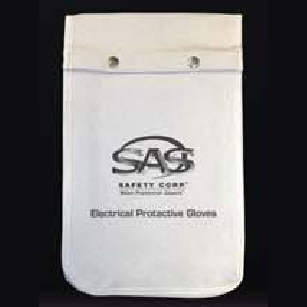HYBRID GLOVE CANVAS BAG
Hybrid vehicles use high voltage batteries and electric motors to achieve
their fuel economy gains. The battery
packs quite a wallop, 144 volts on a Honda Insight or Civic, 201 volts on a
second-generation (2004) Toyota Prius
(which is bumped up to 500 volts by the power inverter at the electric motors!),
275 volts on a first-generation
Toyota Prius (2001-03), 288 volts on a Lexus RX400H and Toyota Highlander, and
330 volts on a Ford Escape
Hybrid. This is more than enough juice to toast anyone who accidentally comes
into contact with the high voltage
battery, wiring or powertrain components.
High voltage direct current is especially dangerous because it typically
causes continuous
muscular contractions that prevent the victim from "letting go." This increases
the likelihood
of deep tissue burns, organ damage and death. Alternating current, by
comparison, is more like to cause heart
fibrillations that may result in death. The threshold voltage where DC becomes
dangerous can be as low as 55 to
60 volts, compared to 110 volts for AC. Ordinary 12 volt DC car batteries and
electrical systems pose no danger,
but the high voltage secondary ignition system can give you a nasty shock
(though the current is usually too low
to cause serious harm).
SAS Safety is pleased to introduce our Hybrid Vehicle Service
Glove. These rubber-insulating gloves are necessary for any technician
servicing hybrid vehicles. Several manufacturers offer hybrid vehicles, with
more models to come. These high voltage system vehicles will likely be serviced
primarily by authorized new car dealers.
Protective Gloves Bag
Heavy duty canvas bag allows storage for both the service gloves and the protective over gloves.
The DOs and DON'Ts ol Hybrid Gloves
What You Need to Know
All collision repair technicians need to wear insulated lineman's "hybrid
gloves" whenever working on or near any high-voltage hybrid components.
Get the right glove-high-voltage gloves must:
• Be rated at 1,000 volts AC max use
• Display a "Class 0" electrical safety glove classification
Inspect gloves before each use, using the following guidelines:
• Check for leaks, tears, punctures or cuts
• Roll gloves up to confirm that they will hold air
• Inspect gloves for ozone damage, which resembles a series of interlacing
cracks
• Check for texture changes, such as softening, hardening, stickiness or lost
elasticity
Storage and protection:
Store in a cool, dark, dry place
Store flat in a protective container or canvas bag
The location should be as free as possible from chemicals, oils, solvents,
damaging fumes and electrical discharges
Keep away from fluorescent light and sunlight
Don't wear watches, rings, jewelry or sharp objects that may damage the gloves
Wash with mild soap to clean
Recertify or replace?
• Gloves must be placed into service within 12 months of production, or be
recertified. After 6 months of use, gloves must be recertified or replaced
One size doesn't fit all!
• Make sure you have the proper size gloves for your hands. To ensure correct
glove size, hold the end of a measuring tape between your thumb and first
knuckle, and then measure the circumference around your knuckles. Add one inch
to that measurement to determine your glove size.
Part #: SU.6465

Price and Units
Units: EACH
|
Units: EACH Product Links: Hybrid Safety Product Description |
Customers Who Looked At This Item Also Looked At:

|
HYBRID VEHICLE SAFETY GLOVES M |
|

|
HYBRID VEHICLE SAFETY GLOVES L |
|

|
HYBRID VEHICLE SAFETY GLOVE XL |
|

|
HYBRID VEHICLE SAFETY GLOVE XX |
|

|
HYBRID OVER GLOVE MEDIUM |
|

|
HYBRID OVER GLOVE LARGE |
|

|
HYBRID OVER GLOVE X-LARGE |
|

|
HYBRID OVER GLOVE XX-LARGE |
|
 HMS Warehousing Corporation
HMS Warehousing Corporation
